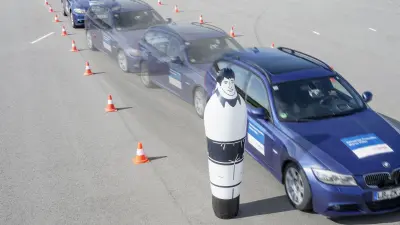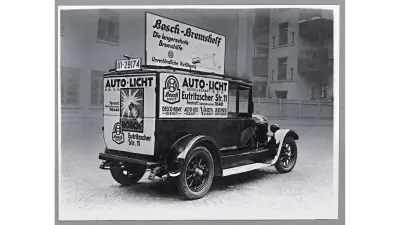Boxberg proving ground
That seat-of-the-pants feel

Skidding through curves in a controlled manner on rain-soaked roads or hovering in the air for a tiny moment when “jumping” off a steep hill: day by day, application engineers at the Boxberg test und proving ground have primarily been calculating, programming and testing the behaviour of control and regulation systems. The ultimate goal: more safety on the roads.
The vehicle skids along the wet pavement at high speed, climbs a steep hill on two wheels, and then remains suspended in midair for a brief second. The co-pilot briefly holds his breath. But the test driver’s sole concern is the performance of the brakes. Finally, the adventure is over, and the test driver becomes a calibration engineer once again. He disappears, laptop under his arm, into one of the offices.
As the story illustrates, the Boxberg proving ground is more than just a spectacular circuit. Offices and workshops are located right next to the course, ensuring physical proximity and protecting the facility from prying eyes. From the start, the office buildings were equipped with hookups for laptops. Logging into the network of the engineering center in Schwieberdingen was fast and easy, and made it easy to access any necessary software updates. In the cozy and compact offices, engineers have had the tools they need to make improvements, reprogram, talk to customers, and run tests.

With little fuss, the proving ground was inaugurated on June 15, 1998. Erwin Teufel, the minister-president of Baden-Württemberg, and Hermann Scholl, the chairman of the Bosch board of management, opened the gates to the test track. The first test vehicles drove on, took off, and were quickly out of sight – until they came back around for their next lap.
The opening ceremony was followed by a series of events, including a summer festival for residents of the nearby town of Boxberg, open houses for Bosch associates, and a get-together for the trade press that quickly became a regular staple in journalists’ calendars.
Test drives have long been integral to the company’s activities. As automotive technology continued to evolve after the second world war, new and modified technologies had to be put through their paces. Even though there was far less traffic on the roads in the late 1950s and 1960s than there is today, test drivers nonetheless preferred to take to public roads late at night for their trials, which focused on injection technology and vehicle electrics. Yet neither the engineers nor the test drivers were particularly satisfied with this setup, and the same went presumably for other road users.
A first, modest test circuit was built along with the engineering center in Schwieberdingen, just north of Stuttgart. Opened in 1968, the engineering center was also where the ABS antilock braking system would be tested. The company found a suitable site for the necessary winter testing in Arjeplog, Sweden. But the development of vehicle dynamics management systems in the late 1980s was too much for the Schwieberdingen “summer test track” in terms of both scope and size. Performing skid tests on public roads was not an option. It became clear that a new circuit was needed, and so the search began.


Boxberg, roughly an hour’s drive north, offered a suitable site and ideal conditions. However, just a few years earlier, an automaker had already tried in vain to set up a test center there for the same purpose – albeit one requiring eight times as much space. And while large-scale projects were important for the prosperity of rural communities, people were now more environmentally aware. From the start, Bosch made it clear that the proving ground would not be a nature reserve, but that it would be designed “in harmony with its natural surroundings.” The company also agreed not to build before the Boxberg locals had given their approval.
Once the municipal council had unanimously voted in favor of the project at a town hall meeting in December 1994, construction began at a fevered pace. The year that followed was used to plan the project, which had a price tag of 100 million German marks. A project group was put together, comprising experts in a variety of fields and with a focus on ABS and brakes. Together, automotive and construction engineering specialists discussed the requirements associated with a high-tech proving ground.
Following the groundbreaking ceremony in early 1996, earthwork started on the 97-hectare site, the largest construction site in southern Germany. A total of 24 million cubic meters of earth was excavated and redeposited elsewhere on the site in order to level the terrain.
The proving ground’s courses were designed as multiple track modules surrounded by a multilane, high-speed oval. A handling course, driving dynamics area, inclined hills, rough-road tracks, and a water track to simulate aquaplaning were a part of it. The tracks and courses were engineered to precisely and uncompromisingly meet the demands of testing. Building the high banked curves, for example, required a special, hydraulically operated curve machine (the only one in the whole world). It was fascinating to watch the roller drums, supported by steel cables, make their way around the banked curves.


For the rough-road tracks, stones had to be brought in from quarries in eastern Germany and Belgium – only they had the required “bumpy” structure. Jürgen Zechmann from the ABS and Braking Systems division, the coordinator of the project, paid the site a visit and laid a few square meters of stone pavement himself. The construction workers had found it difficult to believe how bumpy the road surface was supposed to be. After only two years of construction, the test center and its tracks went into operation. It would prove to be an important step in the further development and testing of control systems such as ABS and new technologies such as ACC adaptive cruise control.
The electronic control modules along the test tracks are programmed for these systems. Because it is impossible to simulate certain disturbance variables on a computer, these road tests have remained invaluable. Sometimes, a driver’s “seat-of-the-pants feel” is the only true gauge of a vehicle’s performance.
Various sections of the test circuit were redesigned in 2015 to allow drivers to use the modules separately. Even customers can test their vehicles under reproducible conditions in everyday situations.
Now, as then, the top priority of the proving ground is road safety. And Boxberg is the place where the calculations, programming, and testing needed to achieve this have been carried out.



